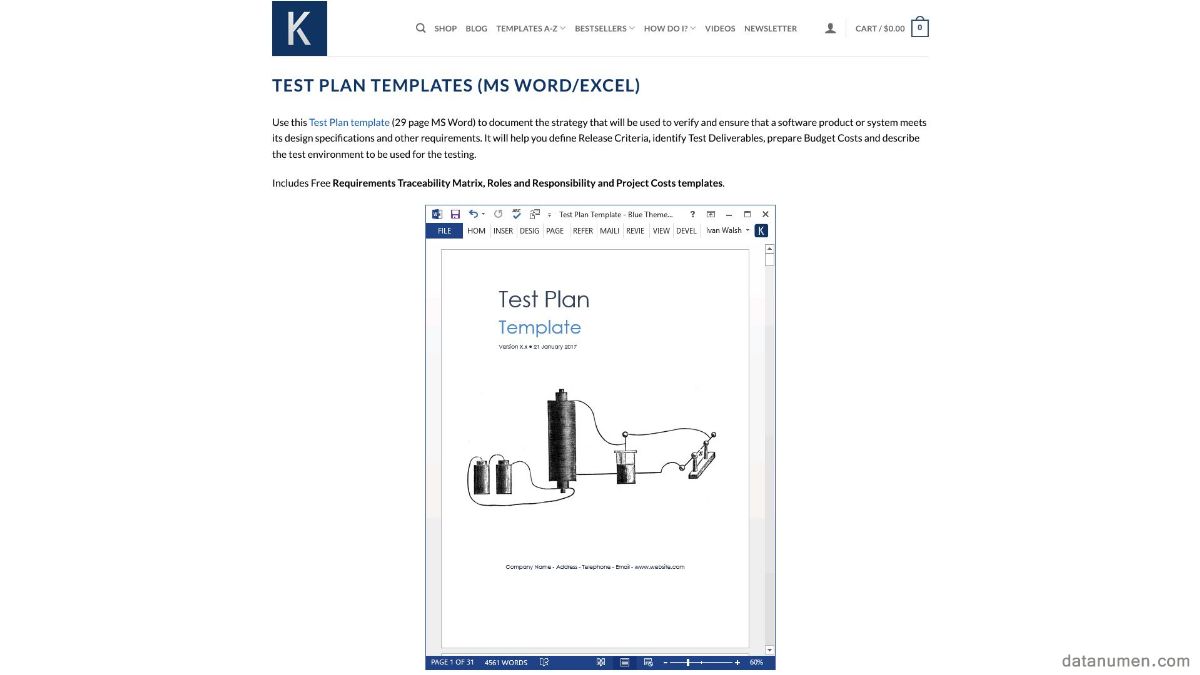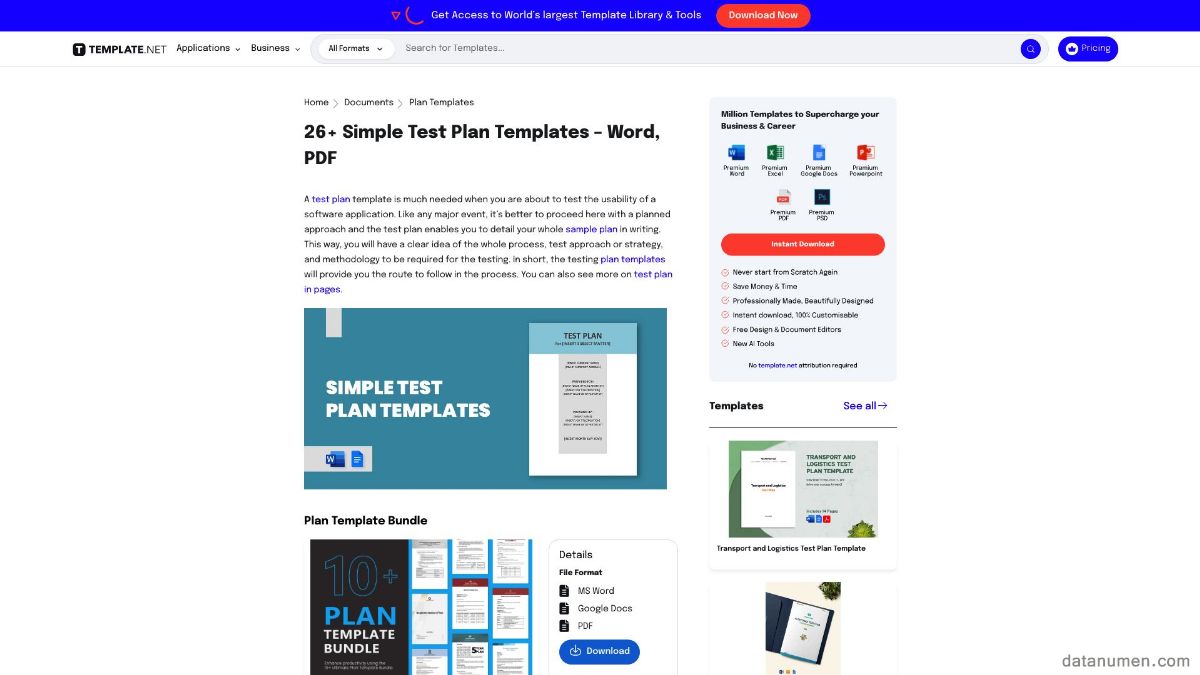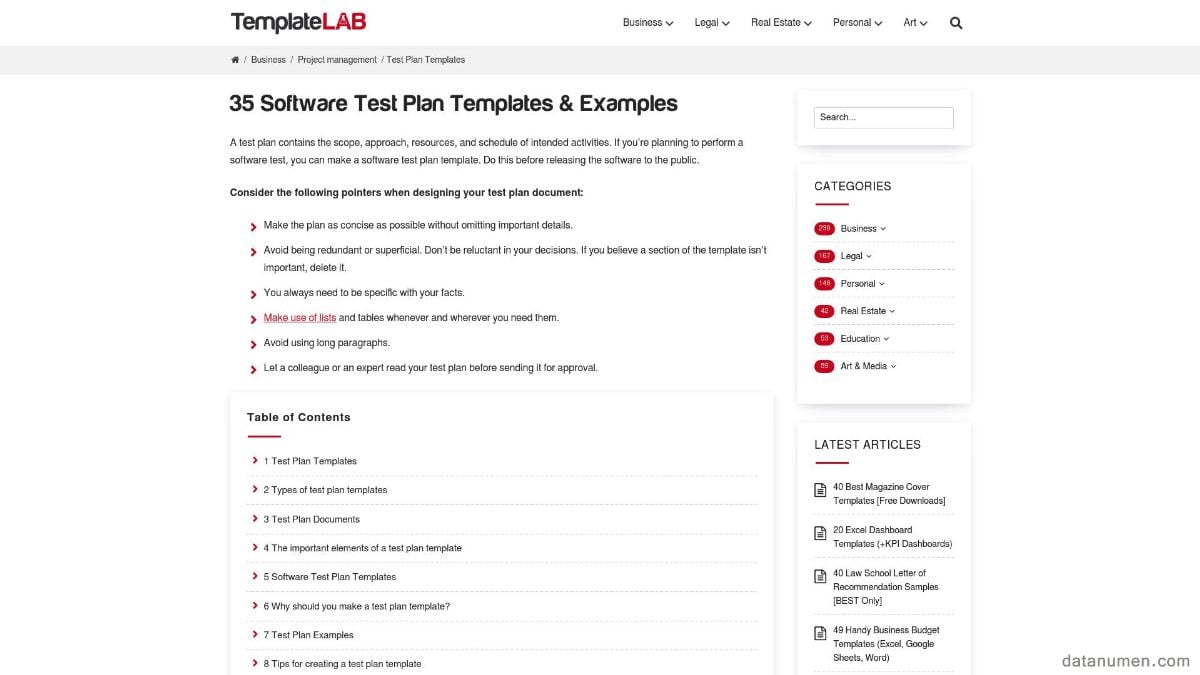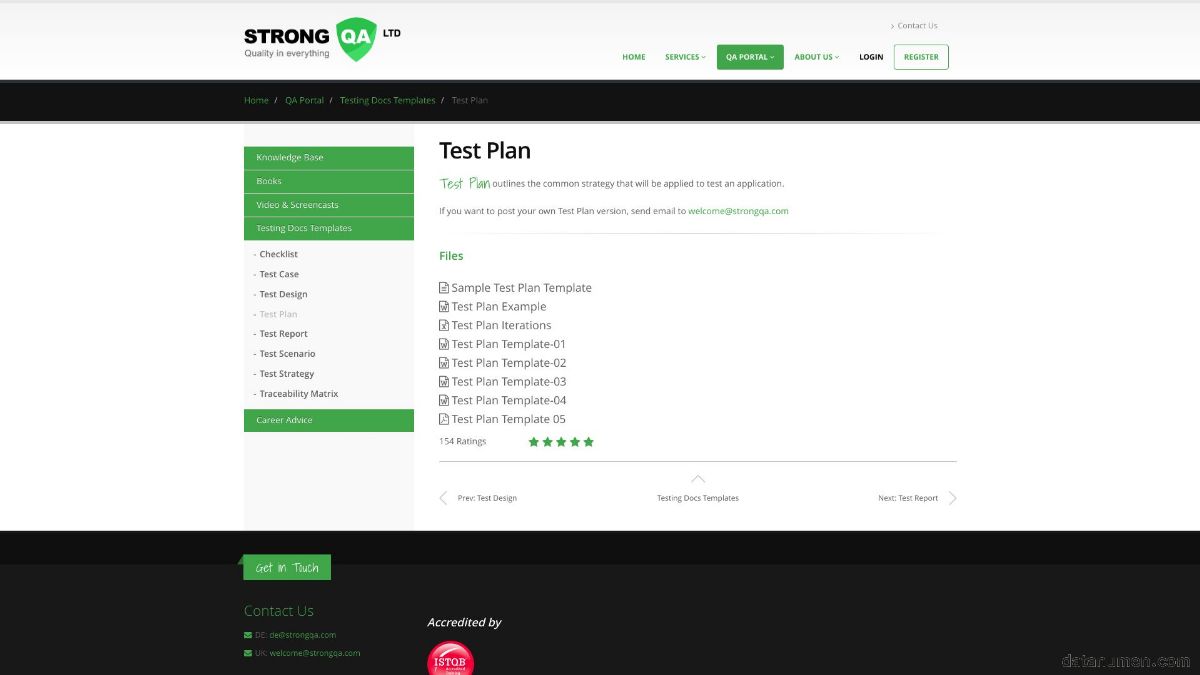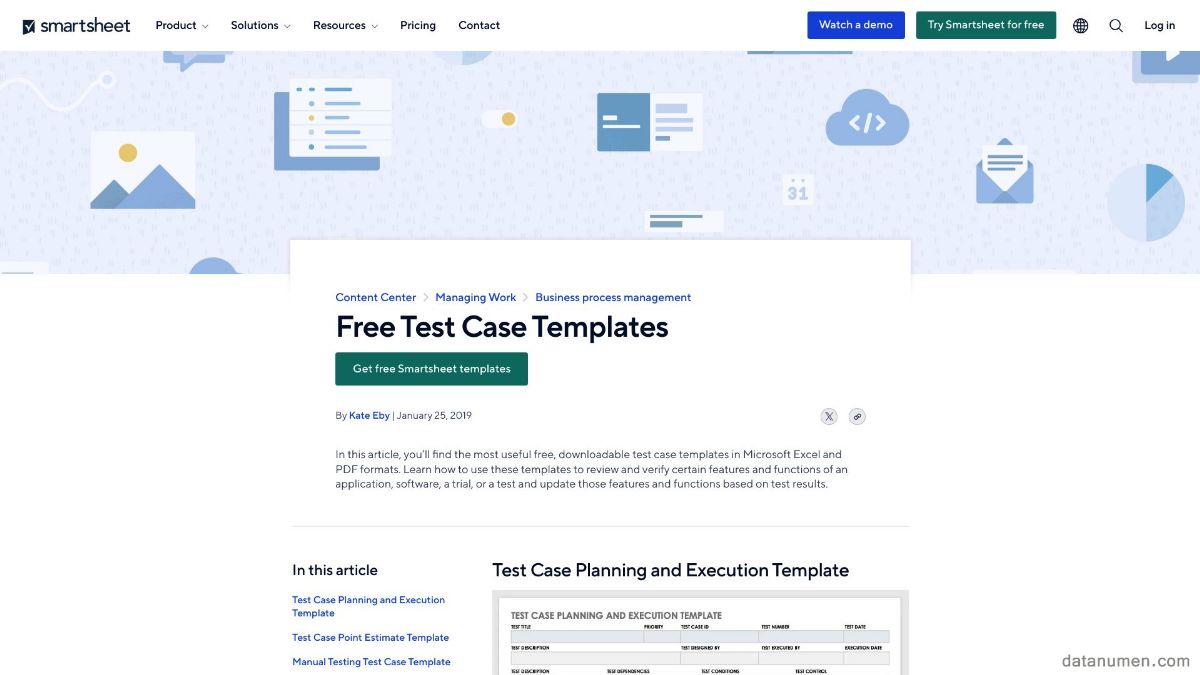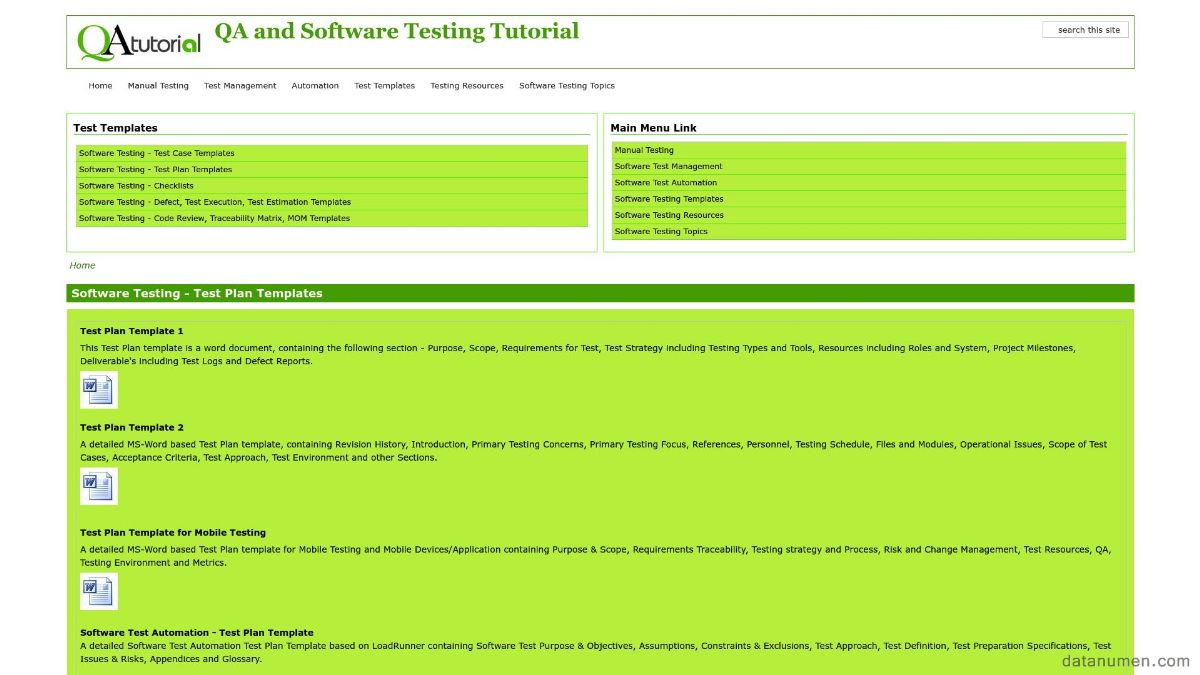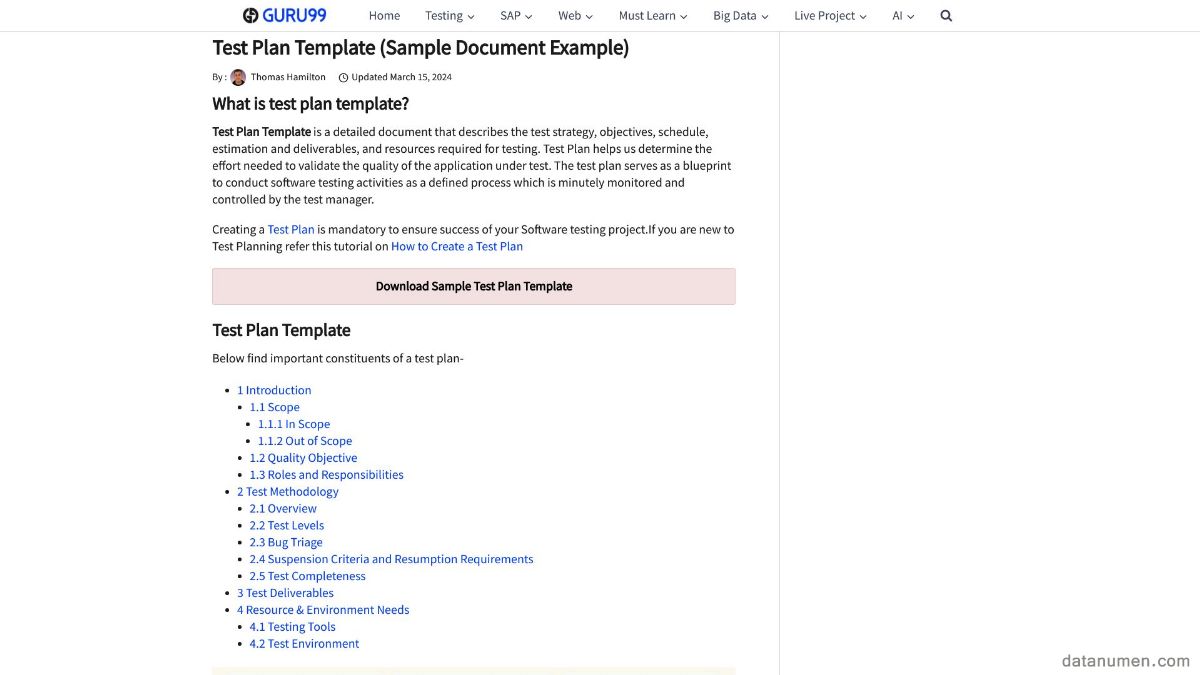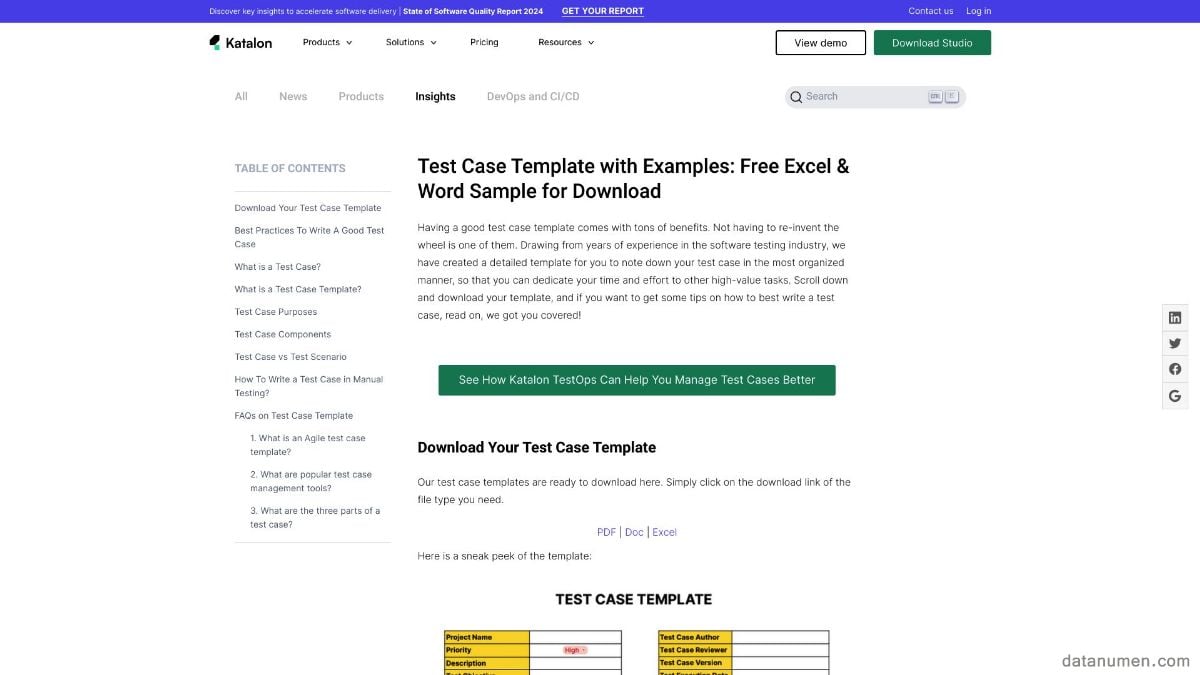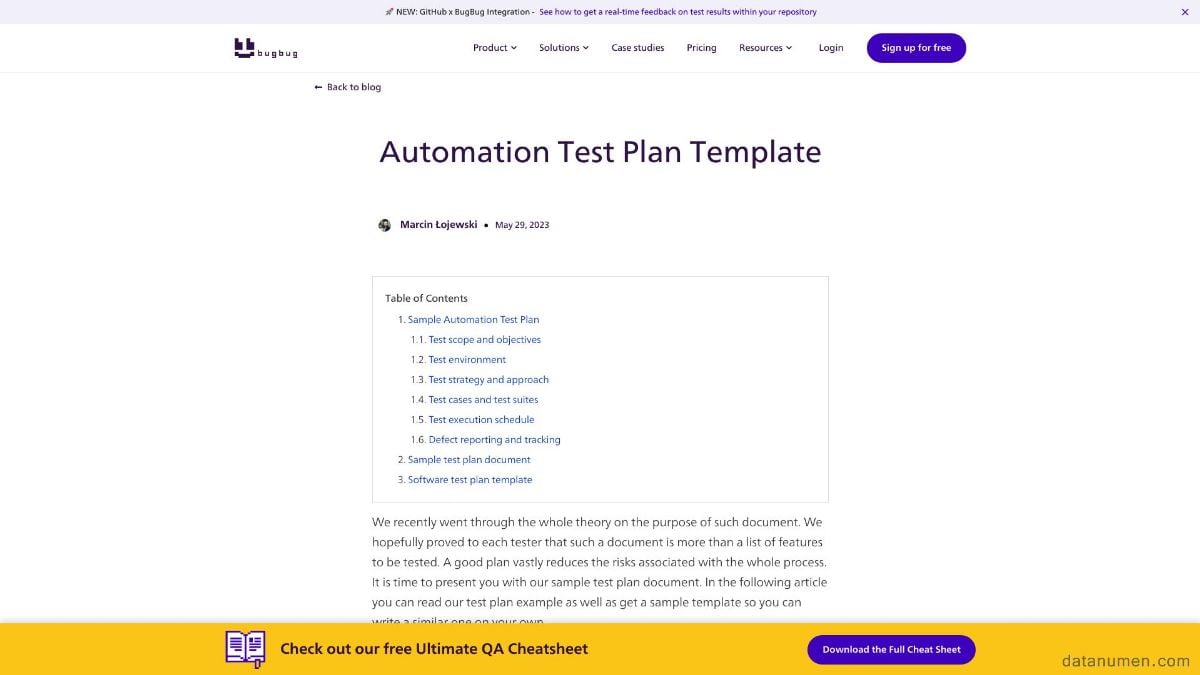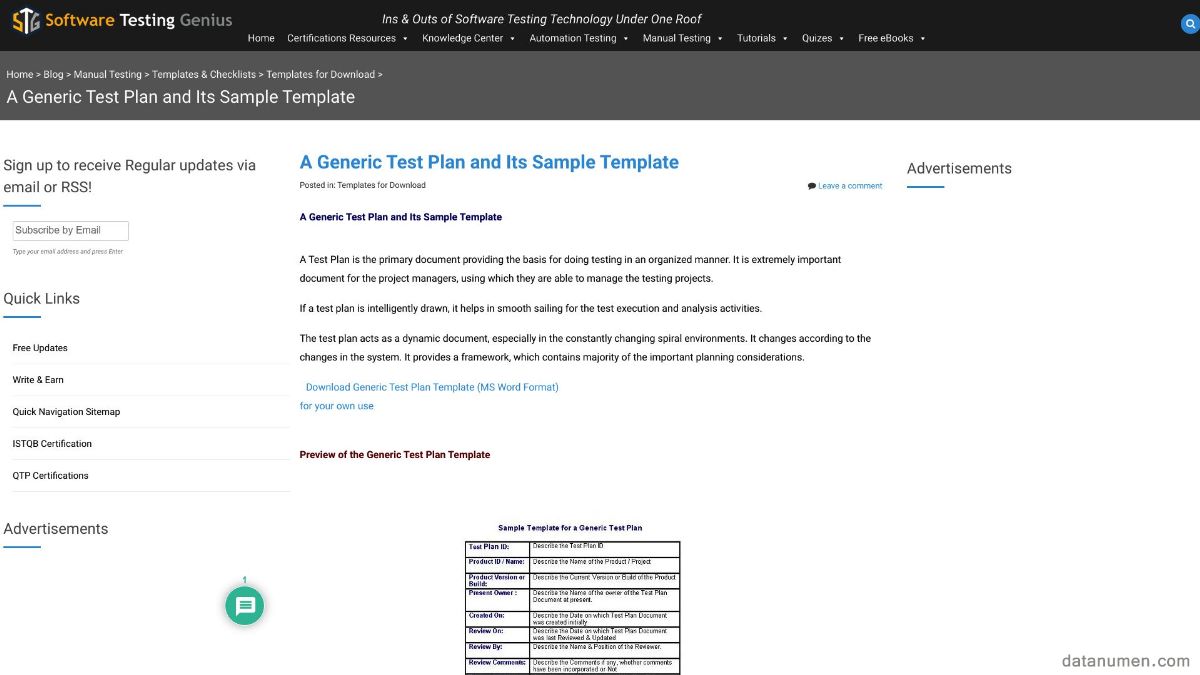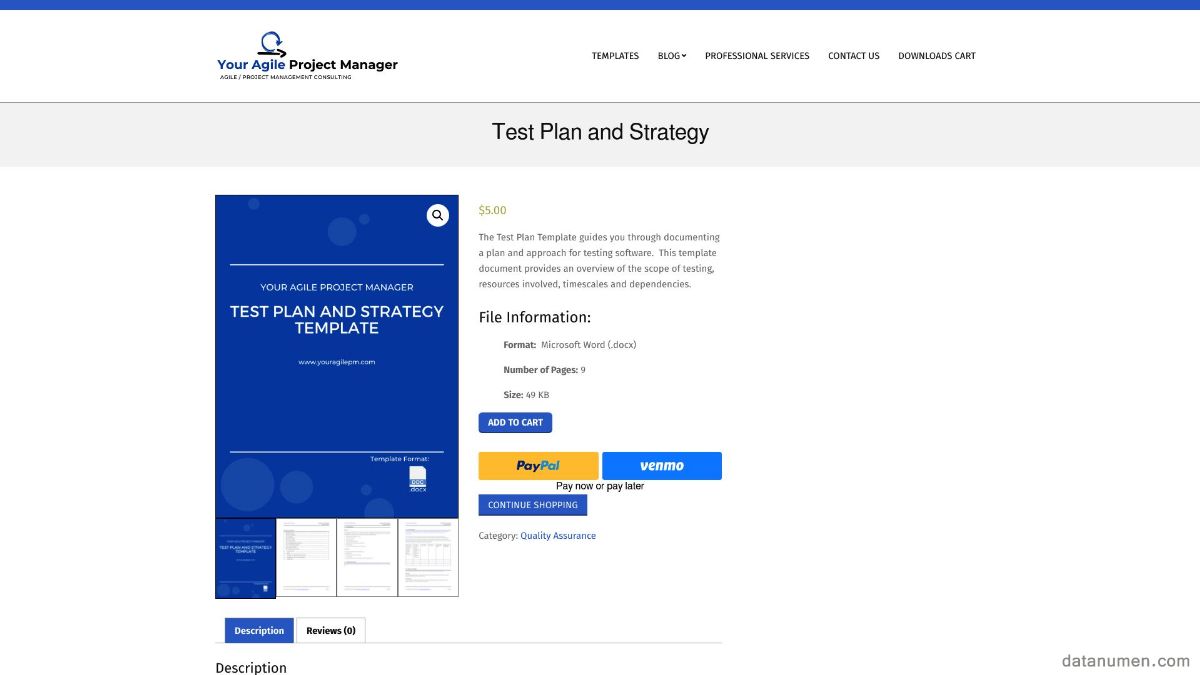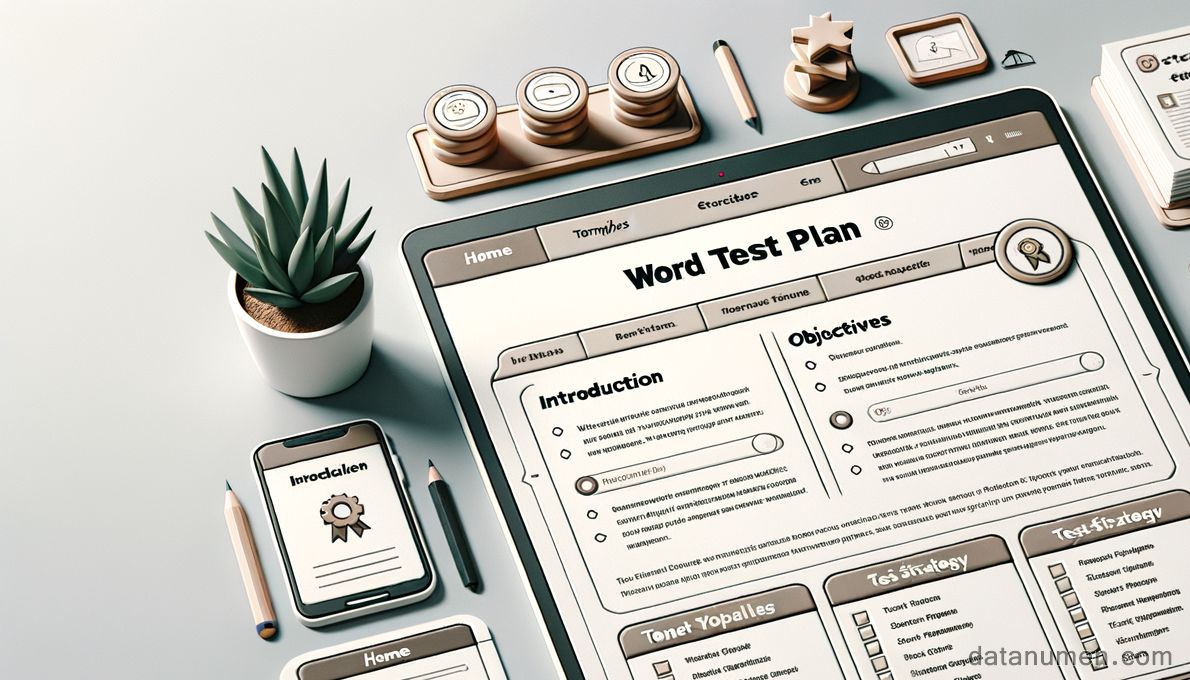1. Introduction
1.1 Importance of Word Test Plan Template Site
Test plans are essential documents in the software development and testing lifecycle. They provide a structured approach to identify testing objectives, strategies, resources, and schedules. Leveraging pre-designed test plan templates can significantly streamline the creation process, ensuring consistency, thoroughness, and efficiency. Microsoft Word is a commonly used tool for drafting such documents due to its versatility and user-friendly interface. Consequently, knowing where to find high-quality Word test plan templates is crucial for project managers, QA teams, and developers.

1.2 Objectives of this Comparison
The primary objective of this comparison is to assist users in selecting the most suitable Word test plan template site for their specific needs. By evaluating various sites based on factors such as template quality, ease of use, comprehensiveness, and additional features, this comparison aims to provide a detailed analysis that empowers users to make informed decisions. The sites reviewed include Klariti, Template.Net, TemplateLab, StrongQA, Smartsheet, QATutorial, Guru99, Katalon, Bugbug, Software Testing Genius, and Your Agile Project Manager.
1.3 Word Repair Tool
We need a powerful Word repair tool to handle corrupt Word documents. DataNumen Word Repair is an ideal option:
2. Klariti TEST PLAN TEMPLATES
Klariti offers a robust collection of test plan templates ideal for software testing projects. These templates are available in both Microsoft Word and Excel formats, providing flexibility for users who prefer different tools. Klariti’s templates are designed to be comprehensive, providing detailed sections that cover all aspects of the test planning process, from objectives and scope to resources and scheduling. With a focus on professionalism and thorough documentation, Klariti aims to facilitate the creation of organized and effective test plans.
2.1 Pros
- Comprehensive coverage: Klariti’s templates include detailed sections that ensure all critical aspects of a test plan are covered, such as objectives, scope, resources, and schedules.
- Multiple formats: Users can choose between Microsoft Word and Excel formats, catering to different preferences and needs.
- Professional design: The templates feature a clean, professional look that enhances readability and usability, making them suitable for formal documentation in business environments.
- Detailed instructions: Klariti provides step-by-step guidance and best practices within the templates, assisting users in completing each section effectively.
2.2 Cons
- Cost: Klariti’s templates are not free, which may be a drawback for users or organizations with limited budgets.
- Customization limitations: While the templates are comprehensive, they may require significant customization to meet specific project needs, which can be time-consuming.
- Learning curve: Users unfamiliar with comprehensive documentation practices may find the templates complex and may need time to understand and use them effectively.
3. Template.Net Simple Test Plan Templates
Template.Net offers a variety of simple test plan templates available in both Word and PDF formats. These templates are designed to be straightforward and easy to use, catering to users who need a quick and efficient solution for their test planning needs. The simplicity of these templates makes them ideal for small to medium-sized projects or for users who are new to test planning and require a basic structure to follow. Template.Net aims to provide accessible and professional templates that help streamline the test planning process.
3.1 Pros
- User-friendly: The templates are designed to be simple and easy to use, making them accessible for users with varying levels of experience in test planning.
- Variety of formats: Available in both Word and PDF, these templates cater to different user preferences for document editing and presentation.
- Quick setup: The straightforward nature of the templates allows for quick setup and immediate use, saving time for project managers and QA teams.
- Free options: Template.Net provides several free templates, which can be highly beneficial for users or organizations operating on a tight budget.
3.2 Cons
- Limited detail: The simplicity of the templates means they may lack the comprehensive detail required for larger or more complex projects.
- Customization required: Users may need to customize the templates significantly to fit their specific project requirements, which can offset some of the time saved.
- Basic design: While functional, the basic design of the templates may not meet the standards of more formal or professionally demanding environments.
- Fewer instructions: Unlike more detailed templates, Template.Net’s offerings may include fewer instructions or best practices, potentially posing challenges for novice users.
4. TemplateLab Software Test Plan Templates & Examples
TemplateLab provides a diverse collection of software test plan templates and examples designed to cater to various testing scenarios and methodologies. These templates are crafted to offer users a comprehensive framework that can be adapted to different types of software projects. TemplateLab focuses on providing high-quality, professionally designed templates that cover all aspects of a test plan, from test strategy to execution and reporting. This makes it a valuable resource for both novice and experienced testers aiming for thorough and effective test planning.
4.1 Pros
- Diverse collection: TemplateLab offers a wide variety of templates that cater to different testing methodologies and project requirements, providing users with ample options.
- Comprehensive framework: The templates cover all critical aspects of a test plan, including test strategy, execution, and reporting, ensuring a thorough approach.
- Professional quality: Templates are professionally designed to meet high standards, making them suitable for formal documentation in business environments.
- Example inclusion: The inclusion of examples alongside the templates helps users understand how to effectively utilize and customize the templates for their projects.
4.2 Cons
- Complexity: The comprehensive nature of the templates may be overwhelming for users who require a simpler or more straightforward solution.
- Premium access: While some templates may be available for free, many high-quality ones require a premium subscription, which could be a drawback for budget-conscious users.
- Customization effort: Despite their thorough default structure, users may still need to invest time in customizing the templates to suit specific project needs.
- Learning curve: Novice users or those unfamiliar with extensive documentation practices may encounter a steep learning curve when first using these templates.
5. StrongQA Test Plan
StrongQA provides a detailed test plan template aimed at helping QA teams organize and execute their testing processes effectively. This template is designed with a focus on thoroughness and precision, ensuring that all critical elements of a test plan are addressed. The StrongQA test plan template is particularly beneficial for teams involved in rigorous software testing cycles, as it offers a structured approach to documenting test activities, objectives, criteria, and resources. StrongQA aims to support quality assurance efforts by providing a robust framework for test planning.
5.1 Pros
- Thorough documentation: The template covers essential components of a test plan in great detail, ensuring comprehensive coverage of all testing aspects.
- Targeted design: Specifically designed for QA teams, the template includes sections tailored to the unique needs of software quality assurance.
- Clear structure: The logical and clear structure of the template helps users systematically document their test plan, improving organization and readability.
- Professional approach: The template’s professional design and detailed sections make it ideal for formal documentation and presentations within a business setting.
5.2 Cons
- Accessibility: The template may not be as readily accessible or user-friendly for those new to test planning or without prior QA experience.
- Customization needs: Users may need to invest time in customizing the template to fit their specific project requirements and organizational practices.
- Learning curve: The comprehensive and detailed nature of the template may require users to spend significant time understanding and navigating its sections.
- Potential cost: Depending on the availability and access model, there may be associated costs that could be a consideration for budget-conscious teams or organizations.
6. Smartsheet Test Case Templates
Smartsheet offers test case templates designed to enhance the planning, execution, and tracking of test cases within software development projects. These templates are available through the Smartsheet platform, which provides a collaborative and interactive environment for managing various project elements. Smartsheet’s test case templates are structured to facilitate detailed documentation of individual test cases, including objectives, test steps, expected results, and actual results. This makes them a powerful tool for QA teams looking to maintain a high level of organization and accuracy in their testing efforts.
6.1 Pros
- Collaborative platform: The Smartsheet environment allows for real-time collaboration and sharing among team members, improving communication and efficiency.
- Interactive features: Smartsheet provides interactive functionalities such as automated workflows, reminders, and alerts, which enhance test case management.
- Comprehensive templates: The test case templates cover all necessary aspects of test documentation, ensuring thorough recording and tracking of test activities.
- Flexibility: The templates are highly customizable, allowing users to adapt them to fit specific project requirements and testing methodologies.
6.2 Cons
- Platform dependence: Users need to be familiar with the Smartsheet platform, which may require additional training or onboarding time for new users.
- Subscription cost: Access to Smartsheet’s full range of features, including advanced test case templates, typically requires a paid subscription.
- Complexity for beginners: The extensive features and functionalities may be overwhelming for users who are new to test case management or collaborative platforms.
- Internet dependency: As a web-based platform, consistent internet access is required to fully utilize Smartsheet’s capabilities, which may be a limitation in certain environments.
7. QATutorial Software Testing – Test Plan Templates
QATutorial offers a range of test plan templates designed specifically to support software testing activities. These templates provide users with a structured approach to documenting test plans, ensuring that all critical elements such as test objectives, scope, strategy, and resources are accurately captured. The templates from QATutorial are tailored for both newcomers and experienced testers, making it a versatile choice for diverse testing projects. By providing clear outlines and examples, QATutorial aims to facilitate the creation of detailed and effective test plans that enhance the overall quality assurance process.
7.1 Pros
- Targeted for QA: The templates are specifically designed for software testing, ensuring they meet the unique needs and requirements of QA teams.
- Detailed templates: Each template is comprehensive, covering essential elements like objectives, scope, strategy, and resources, which helps in thorough documentation.
- Accessibility: QATutorial offers templates that are easy to access and use, catering to both beginners and experienced testers with user-friendly designs.
- Instructional support: The site often includes additional guidance and examples that aid users in effectively completing and customizing their test plans.
7.2 Cons
- Limited variety: The range of templates available might be narrower compared to other comprehensive template providers, potentially limiting options for specialized needs.
- Customization required: Although detailed, these templates may still require significant customization to align with specific project requirements and organizational practices.
- User experience: The simplicity of the templates, while accessible, might not meet the professional design standards required for formal presentations in some business contexts.
- Resource limitations: Users seeking advanced features or more sophisticated templates might find QATutorial’s offerings somewhat basic and limited in scope.
8. Guru99 Test Plan Template (Sample Document Example)
Guru99 offers a comprehensive test plan template designed to assist QA teams and project managers in effectively documenting and managing their testing activities. This template is accompanied by a sample document that provides a clear example of how to complete each section, making it particularly useful for users who are new to test planning. The Guru99 test plan template covers all essential components, including test scope, objectives, resources, schedule, and risk management, providing a thorough framework for creating detailed and organized test plans.
8.1 Pros
- Educational focus: Guru99 provides detailed guidance and examples alongside the template, making it an excellent learning resource for beginners.
- Comprehensive coverage: The template includes sections for all critical elements of a test plan, ensuring that no important aspects are overlooked.
- User-friendly: The straightforward design and clear instructions make the template easy to use, even for those with limited experience in test planning.
- Free resource: The test plan template and accompanying sample document are available for free, making them accessible to a wide range of users and organizations.
8.2 Cons
- Basic design: The simplicity of the template may not meet the aesthetic or professional design standards required for formal documentation in some business environments.
- Customization effort: Users may need to spend time customizing the template to fit their specific project needs and organizational practices, which can be time-consuming.
- Limited features: The template may lack advanced features and functionalities that more sophisticated tools and platforms provide for test planning and management.
- Static format: As a static template, it may not support real-time collaboration or interactive features that could enhance team coordination and efficiency.
9. Katalon Test Case Template with Examples
Katalon provides a well-structured test case template, complete with examples, aimed at enhancing the efficiency and accuracy of software testing processes. The template is designed to help QA teams systematically document test cases, including test steps, expected results, and actual outcomes. Katalon’s offering is particularly beneficial for users of their automation testing tools, ensuring an integrated approach to test management. By providing both the template and practical examples, Katalon assists users in understanding how to effectively create and utilize test cases to improve overall testing quality.
9.1 Pros
- Integrated with Katalon tools: The template is designed to seamlessly integrate with Katalon’s suite of automation testing tools, providing continuity and efficiency in test management.
- Comprehensive documentation: The template ensures detailed documentation of test cases, including steps, expected results, and actual outcomes, promoting thorough testing practices.
- Practical examples: The included examples provide clear guidance on how to complete each section of the template, making it easier for users to get started.
- Enhances accuracy: The structured format helps reduce errors and inconsistencies in test documentation, leading to more reliable and accurate testing outcomes.
9.2 Cons
- Dependency on Katalon: While the template can be used independently, it is best utilized in conjunction with Katalon’s tools, which may limit its appeal to users of other testing frameworks.
- Learning curve: Users unfamiliar with Katalon’s ecosystem may need time to learn how to effectively integrate and use the template within their testing processes.
- Customization needs: Depending on the specific requirements of a project, users may need to customize the template significantly, which can be time-consuming.
- Limited interactivity: As a static document, the template does not offer real-time collaboration or interactive features that dynamic test management platforms provide.
10. bugbug Automation Test Plan Template
Bugbug offers an automation test plan template designed to assist QA teams in planning and executing automated test processes. This template focuses on the unique needs and challenges of automation testing, providing a structured framework that addresses key elements such as test environment, tools, scripts, and execution schedules. Bugbug aims to simplify the planning phase, making it easier to organize and manage automated tests systematically. With a focus on efficiency and thoroughness, the bugbug automation test plan template is a valuable resource for teams looking to streamline their testing workflows.
10.1 Pros
- Automation focus: The template is specifically designed for automation testing, addressing the particular requirements and complexities of automated test processes.
- Structured framework: The template provides a clear, organized structure that helps ensure all critical aspects of automation testing are covered, from environment setup to script execution.
- Efficiency enhancement: By offering a predefined framework, the template helps streamline the planning phase, saving time and reducing the likelihood of missing important details.
- Tool integration: The template is built to be compatible with various automation tools, making it versatile and useful for different testing environments.
10.2 Cons
- Specialized use: The template is highly specialized for automation testing, which might limit its applicability for manual or other types of testing projects.
- Customization required: Depending on the specifics of the automation project, users may need to customize the template significantly, which can be time-consuming.
- Learning curve: Users new to automation testing or unfamiliar with bugbug’s approach may need time to fully understand and effectively utilize the template.
- Static format: As a static document, the template lacks interactive features and real-time collaboration capabilities, which can be a limitation for some teams.
11. Software Testing Genius A Generic Test Plan And Its Sample Template
Software Testing Genius provides a generic test plan template designed to serve as a comprehensive framework for various types of software testing projects. This template includes a sample document to illustrate the practical application of each section, helping users to understand and utilize it more effectively. The template covers all fundamental aspects of a test plan, such as test objectives, scope, resources, schedule, and risk management. With its all-encompassing design, Software Testing Genius aims to support QA teams in creating detailed and organized test plans, regardless of the specific testing methodology or project size.
11.1 Pros
- Versatility: The generic design of the template makes it adaptable to a wide range of testing projects, from simple to complex.
- Comprehensive coverage: The template addresses all fundamental components of a test plan, ensuring thorough documentation.
- Educational value: The inclusion of a sample document provides clear guidance on how to complete each section, making it especially useful for novice users.
- Accessibility: The template is easy to access and use, making it a practical tool for QA teams and project managers at various experience levels.
11.2 Cons
- Basic design: The generic nature of the template may result in a fairly basic design, which might not meet the aesthetic or professional standards required for some formal environments.
- Customization needs: Users may need to spend considerable time adapting the template to align with their specific project requirements and organizational practices.
- Limited advanced features: As a static document, the template may lack advanced functionalities offered by more sophisticated test planning tools and platforms.
- Potential information overload: The comprehensive nature of the template might be overwhelming for users who require a simpler or more streamlined approach to test planning.
12. Your Agile Project Manager Test Plan And Strategy
Your Agile Project Manager offers a test plan and strategy template tailored for agile project environments. This template is designed to support the dynamic and iterative nature of agile projects, providing a framework that aligns with agile principles and methodologies. It includes sections for key elements such as testing objectives, scope, resources, timelines, and risk management, all structured to accommodate continuous delivery and iterative development cycles. By focusing on flexibility and adaptability, Your Agile Project Manager aims to provide a valuable resource for agile teams seeking to enhance their test planning processes.
12.1 Pros
- Agile alignment: The template is specifically designed to fit agile project environments, supporting iterative development and continuous delivery.
- Flexibility: The structure of the template allows for easy updates and modifications, making it adaptable to changing project requirements and development cycles.
- Comprehensive coverage: Despite its agile focus, the template covers all essential components of a test plan, ensuring thorough documentation.
- Resource-efficient: The template’s design promotes efficient use of resources, helping teams manage their testing activities effectively within an agile framework.
12.2 Cons
- Agile-specific: The template’s focus on agile methodologies may limit its applicability for teams using traditional or other types of development approaches.
- Customization required: Depending on the specific requirements of the project, users may need to invest time in customizing the template to suit their needs.
- Premium access: Access to the template may require a purchase or subscription, which could be a consideration for budget-conscious teams or organizations.
- Learning curve: Teams not familiar with agile practices may need additional time and training to effectively utilize the template within their workflow.
13. Summary
13.1 Overall Comparison Table
| Site | Template Count | Features | Price | Customer Support |
|---|---|---|---|---|
| Klariti TEST PLAN TEMPLATES (MS WORD/EXCEL) | Multiple | Comprehensive coverage, Multiple formats, Professional design, Detailed instructions | Paid | Available |
| Template.Net Simple Test Plan Templates – Word, PDF | Variety | Simple, User-friendly, Multiple formats, Free options | Free/Paid | Limited |
| TemplateLab Software Test Plan Templates & Examples | Diverse | Diverse collection, Comprehensive framework, Professional quality, Example inclusion | Free/Paid | Available |
| StrongQA Test Plan | Single | Thorough documentation, Targeted design, Clear structure, Professional approach | Varies | Available |
| Smartsheet Test Case Templates | Multiple | Collaborative platform, Interactive features, Comprehensive templates, Flexibility | Paid | Available |
| QATutorial Software Testing – Test Plan Templates | Range | Targeted for QA, Detailed templates, Accessibility, Instructional support | Free/Paid | Limited |
| Guru99 Test Plan Template (Sample Document Example) | Single | Educational focus, Comprehensive coverage, User-friendly, Free resource | Free | Limited |
| Katalon Test Case Template with Examples | Single | Integrated with Katalon tools, Comprehensive documentation, Practical examples, Enhances accuracy | Free | Available |
| bugbug Automation Test Plan Template | Single | Automation focus, Structured framework, Efficiency enhancement, Tool integration | Free | Limited |
| Software Testing Genius A Generic Test Plan And Its Sample Template | Single | Versatility, Comprehensive coverage, Educational value, Accessibility | Free | Limited |
| Your Agile Project Manager Test Plan And Strategy | Single | Agile alignment, Flexibility, Comprehensive coverage, Resource-efficient | Paid | Available |
13.2 Recommended Template Site Based on Various Needs
Based on the comparison, different template sites cater to different needs and preferences. Here are the recommendations:
- For Comprehensive Test Plans: Klariti offers detailed templates with multiple formats, making it ideal for thorough documentation needs.
- For Simplicity and Quick Setup: Template.Net provides user-friendly, simple templates with free options, suitable for users looking for immediate solutions.
- For Diverse Testing Needs: TemplateLab provides a wide variety of templates for different methodologies, ideal for users requiring versatility.
- For Collaborative Environments: Smartsheet offers interactive and collaborative features, making it perfect for team-based projects.
- For Automation Testing: bugbug provides a focused framework specifically for automation scenarios.
- For Agile Projects: Your Agile Project Manager offers templates aligned with agile principles, ideal for iterative development processes.
14. Conclusion
14.1 Final Thoughts and Takeaways for Choosing a Word Test Plan Template Site
Choosing the right Word test plan template site is crucial for ensuring effective and efficient software testing processes. Each site offers unique features and benefits tailored to different project needs and user expertise levels. Klariti stands out for its comprehensive and professionally designed templates, making it an excellent choice for detailed documentation. Template.Net, with its simplicity and free options, is ideal for quick setups and users looking for immediate solutions without extensive customization.
For those who require versatility in their templates, TemplateLab provides a diverse collection suitable for various testing methodologies. Smartsheet’s collaborative platform is perfect for team-based projects that benefit from real-time updates and interactive features. Bugbug’s automation-focused templates cater specifically to the needs of automated testing processes, while Your Agile Project Manager aligns its templates with agile principles, making it ideal for iterative and continuous delivery projects.
The final choice should be guided by the specific requirements of your project, the complexity of your testing processes, and the level of detail needed in your test plans. Additionally, consider factors such as the ease of use, customization capabilities, associated costs, and available customer support. By carefully evaluating these aspects, you can select a template site that not only meets your immediate needs but also supports your long-term software testing objectives.
Ultimately, the right template can streamline your test planning, ensure comprehensive test coverage, and contribute to the overall success of your software development projects. Whether you are a novice looking for guidance or an experienced tester requiring robust documentation, there is a suitable option available to meet your needs.
Author Introduction:
Vera Chen is a data recovery expert in DataNumen, which provides a wide range of products, including a great tool to recover Excel files.

